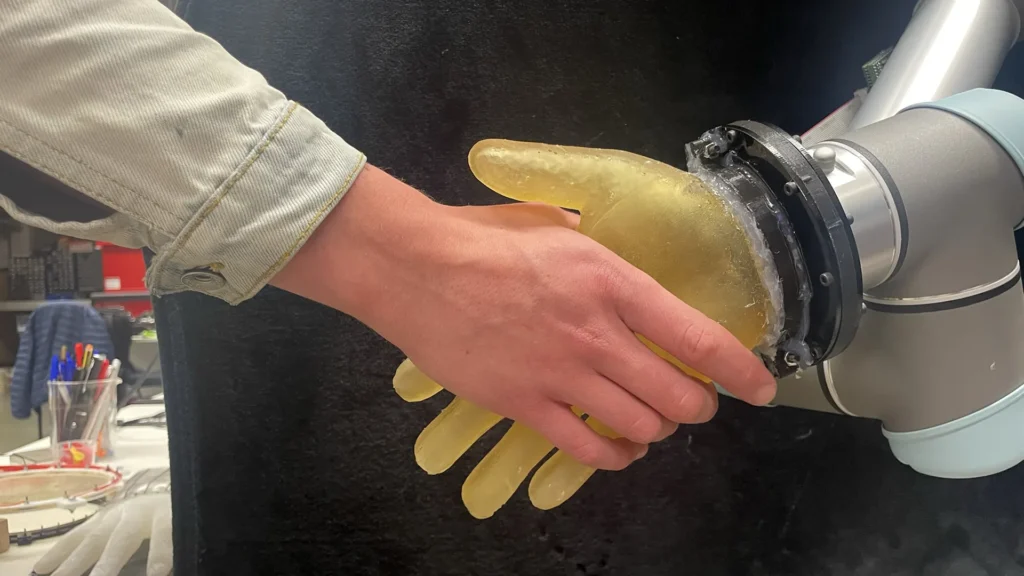Scientists have developed a low-cost, durable, highly sensitive robot “skin” that can be added to the robot’s hands like gloves, allowing the robot to detect information about its surroundings in a way similar to humans.
Researchers from the University of Cambridge and University College London (UCL) have developed flexible conductive skin that is easy to manufacture and can melt and form a variety of complex shapes. The technology perceives and processes a series of physical inputs, allowing robots to interact with the physical world more meaningfully.
Unlike other solutions for robotic touch, robotic touch usually works through sensors embedded in small areas and requires different sensors to detect different types of touch, the entire electronic skin developed by Cambridge and UCL researchers is a sensor that brings it closer to our own sensor system: Our skin: Our skin.
Although robotic skin is not as sensitive as human skin, it can detect signals from over 860,000 small pathways in the material, allowing it to recognize different types of touch and pressure (such as taps of fingers, hot or cold surfaces, damage caused by cuts or stabbing, or touching multiple points in a single material.
The researchers combined physical testing and machine learning techniques to help robotic skin “learn” these pathways most important, thus allowing different types of contact to be more efficiently perceived.
In addition to potential applications for humanoid robots or human prostheses, the researchers say robotic skin may be useful in the automotive sector or in the industry that is disaster relief, the researchers say. Results are reported in journals Science Robotics Technology.
Electronic skin works by converting physical information such as pressure or temperature into electronic signals. In most cases, different types of sensors are needed to perform different types of touch – one that detects pressure, another for temperature, etc. – and then embedded into a soft flexible material. However, signals from these different sensors can interfere with each other and the material can easily be damaged.
“Different sensors with different types of touches can lead to the manufacture of complex materials,” said David Hardman, lead author of the Cambridge Engineering Division. “We wanted to develop a solution that can detect multiple touches at once but a single material.”
“At the same time, we need something cheap and durable to suit a wide range of use,” said UCL co-author Dr. Thomas George Thuruthel.
Their solution uses one type of sensor to respond differently to different types of touches, called multimodal sensing. While separating the causes of each signal is a challenge, multimodal sensing materials are easier to manufacture and more robust.
The researchers melted a soft, elastic and conductive gelatin hydrogel and cast it into human hands. They tested a range of different electrode configurations to determine which provide them with the most useful information about different types of touches. Due to the tiny pathways in conductive materials, there are only 32 electrodes placed on the electrodes on the wrist.
The skin was then subjected to different types of touch tests: the researchers blew it up with a heat gun, pressed it with their fingers, touched it gently with their fingers, and even cut it open with a scalpel. The team then used the data collected during these tests to train the machine learning model so that the hands could recognize different types of touch meanings.
“We were able to squeeze a lot of information out of these materials – they could do thousands of measurements very quickly,” Hardman said. “They measured many different things at once on a large surface area.”
“Our level is not as good as human skin, but we think there is anything else to do right now,” Thuruthel said. “Our approach is more flexible and easier to build than traditional sensors, and we are able to calibrate using human touch for a range of tasks.”
In the future, researchers hope to improve the durability of electronic skins and conduct further testing of real-world robotic tasks.
The research was obtained by Samsung Global Research Outreach Program, the Royal Society and the Engineering and Physical Science Research Council (EPSRC), part of the UK Research and Innovation (UKRI). Fumiya Iida is a member of the Corpus Christi College in Cambridge.
